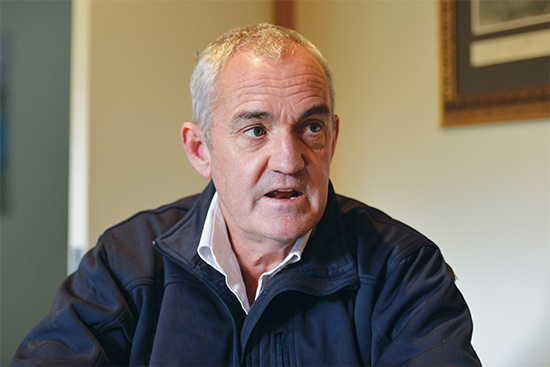
Andrew McLean looks at the equitation science principles and asks – Are you training according to these scientifically based principles? Don’t get put off by the academic terminology, it is important for your horse that you understand these concepts because they enable maximum efficiency in training. In the same way engineers understand vehicle mechanics beyond simply driving them, horse trainers can achieve optimal training efficiently by understanding the natural behaviours, learning abilities and biomechanics by taking account of available knowledge.
Let Andrew tell us more:
These principles can be seen as benchmarks for ethical standards of training that make our sports sustainable. These Ten Principles were overhauled by Andrew and Professor Paul McGreevy and have then been peer-reviewed by a panel of 10 behavioural scientists. The details of these principles can be found on the International society for equitation Science website: http://www.equitationscience.com/learning-theory-in-equitation. So here is the first one:
DOES YOUR TRAINING DEMONSTRATE recognition of your horse’s basic needs?
Train according to the horse’s ethology and cognition
What does this mean? You need to take into account the way horses live naturally:
Ethology is the study of animal behaviour that provides information on how horses have evolved to live. It helps to explain natural equine social structures, including complex dynamic social organisation with a social rank that determines access to resources. Horses show ‘bilateral dominance’ patterns which means that they each have individual relationships with the others however there is no evidence that they understand or care, for that matter, about relationships between the others in the social group. In other words they are not hierarchical so much as they have individual relationships with each other. This explains the complex patterns seen in all feral equids that defies hierarchical explanations. Horses need the company of their own species and readily form attachment bonds, so isolation is detrimental. They have evolved to walk and graze for 16 hours per day and their digestive system and brain wiring have adapted to this regimen.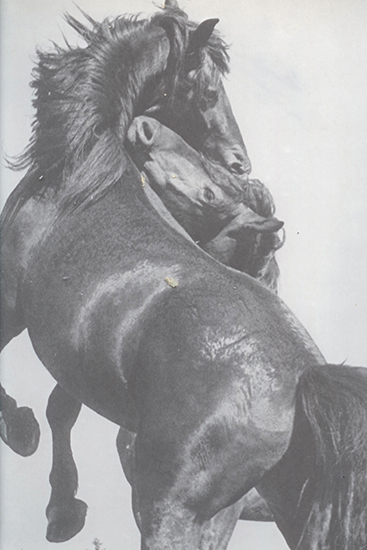
You need to take into account how horses think:
Cognition refers to the ways animals process information about the world. Compared to humans, their prefrontal cortex in the brain is diminished, so horses may not recall events as we do. In all mammals including humans, the duration of memories lasts only around 3 seconds. In humans and other animals such as cooperative predators (e.g. wolves and lions), there are specific neural tissues that refresh memory pathways in the prefrontal cortex. The absence of this in horses means that they do not visualise stimuli that they cannot see. However if the stimulus is associated with a certain reaction, then it will trigger a behaviour. The lack of recall means that equine memories are not subject to corruption through imagination and visualisation but remain perfectly intact. Memorising and recognising stimuli that trigger certain responses – this is what keeps them safe. We must be careful not to overestimate equine intelligence (e.g., “he knows what he did wrong”), especially in an attempt to justify punishment. Equally, we should not underestimate equine intelligence by supposing that horses don’t have emotions and feelings.
Our latest research shows that attachment, arousal and emotions affect the efficiency of the various learning processes in very individual and interesting ways.
WELFARE IMPLICATIONS: Over- or underestimating horses’ intelligence has negative welfare implications. Isolation, restricted locomotion and foraging have welfare implications.
You need to know how to train effectively:
Use learning theory appropriately
DOES YOUR TRAINING DEMONSTRATE the appropriate use of the key concepts of learning theory – Habituation, Sensitisation, Operant conditioning, Shaping and Classical Conditioning?
The world is a frightening place to a horse – you can make your horse more comfortable by using the learning process of Habituation…
Habituation is recognised when animals stop responding to events and stimuli as they become accustomed to them. Horses are innately fearful of the new/unfamiliar (i.e., neophobic) and often find the characteristics of various stimuli aversive (e.g., size/magnitude; novelty; proximity; and sudden appearance or occurrence). Movement, especially if erratic or advancing towards them, may be hard for them to identify, even when familiar. Habituation can be used to defuse reactions to aversive stimuli in a process called desensitisation. Systematic desensitisation, approach conditioning, overshadowing and counter-conditioning are some methods of desensitisation.
Overshadowing is very effective in getting a horse used to clippers or needles. When the horse sees the person approaching with the clippers it becomes hyper-reactive and pulls against the handler’s lead rein pressures in its attempts to escape. The solution involves the horse being trained to step back and forward from lead rein pressure so that the horse’s reaction is elicited from the lightest of lead rein cues. Next the person with the clippers approaches the horse and as soon as the horse displays the lowest level of fear, the person with the clippers stops so that the distance between the horse and the clippers remains constant. The horse is then asked to step back and forward from lead rein aids. Initially the horse is delayed and its reaction to light pressure is ignored and his attentional mechanisms are overshadowed by the clippers so the handler then increases the motivational pressure of the lead rein so that in a few repetitions the horse is now responding to light signals of the lead rein. The horse’s fear reaction to the clippers has, at this distance, decreased. The clippers are now brought closer to the horse and as soon as he shows the slightest fear reaction, the process is repeated. This process continues until the horse’s response to the clippers has diminished and he can be touched with the clippers and then clipped.
Sensitisation is when an individual’s response intensity is increased. If an individual experiences a series of arousing stimuli, sensitisation describes the likelihood that it will respond more quickly or with more intensity to this or another stimulus that is presented soon after. If the horse has learned to be non-responsive to the leg aids as well as the tapping of the dressage whip then the leg aid can be sensitised by re-training the horse to go from the whip tap alone. For example the horse can be trained to go from halt to walk, then walk to trot and then ultimately halt to trot from just two light whip taps, the whip taps should only be taps (i.e. ones you can withstand). The rhythm of the tapping should remain regular. As soon as arousal levels rise, the horse will now be sensitised to leg aids also. Riders should take care not to get into this situation by nagging the horse with the leg aids.
Now let’s look at one of the key concepts – the concept at the heart of your training program, operant conditioning, which basically means getting your horse to do what you want it to do, but in a clever way that is not stressful to the horse, or you. This is fundamental because there will be unintended consequences where the horse may revert to one of the three ways of coping with stress: hyper-reactivity where he attempts to flee, aggression or reverting to apathy and dullness. These may threaten the safety of humans and horses alike.
Operant conditioning describes training using rewards and consequences. There are 4 subsets and the first is simple, horse does what you want, you reward him:
1. Positive reinforcement: The addition of something the horse values to increase the occurrence of a desired behaviour. Primary reinforcers can be any resource that horses naturally value. Examples used in training are food and touch. To be used as rewards in training, they must be issued to the horse immediately at the onset of the correct response. Secondary positive reinforcers have to be linked to primary reinforcers. They often take the form of auditory stimuli, such as a clicker or a consistent vocalised sound (e.g. ‘Good Boy’) issued when the desired response is offered.
Now the slightly more controversial topic – negative reinforcement, but as Andrew explains, this is just the removal of any pressure…
2. Negative reinforcement: The removal of something the horse wants to avoid, to increase the occurrence of a desired behaviour. Negative reinforcement can and should be very subtle. Pressure motivates horses but the release of that pressure is what trains them. Applying pressure for inter-gait and intra-gait transitions relies on the trainer beginning with a light pressure cue followed by the maintenance or increase of the pressure and then the release. Good trainers always aim to reduce cues to light forms of pressure. Negative reinforcement takes many forms and explains how horses are self rewarded when they remove riders (when they buck or shy), or remove your hand (when head-shy).
Even more controversial is positive punishment – our experts warn this is a last resort…
3. Positive punishment: Adding something aversive to reduce the occurrence of a behaviour (an example would be smacking the horse for kicking.) Positive punishment has negative welfare implications so should be avoided. If used, it must be connected in time with the undesirable behaviour. Delays of any sort do not work.
4. Negative punishment: Removing something the horse values to reduce the occurrence of a behaviour. Negative punishment is rarely used except for prompt removal of attention to suppress a behaviour. Once again, if delayed, it is ineffective.
As good trainers know, education is a process of building blocks – it’s called ‘shaping’…
Shaping is the gradual step-by-step building of behaviours. Each step should differ only slightly from the previous step so that it is as obvious as possible for the horse to trial (or offer) the correct/desired response.
Training is timing…
Classical conditioning uses cues and signals to trigger and elicit behaviours. They must be timed with exquisite precision to coincide with the start of the desired behaviour. So voice, seat and body posture cues should be consistently given just before a rein or leg aid so as to elicit the same response.
WELFARE IMPLICATIONS: The use of inconsistent pressure and/or prolonged discomfort has the potential for serious welfare implications that range from escape, aggression and apathy to learned helplessness.
But it is also making the signals easy to understand:
Train easy-to-discriminate signals
DOES YOUR TRAINING DEMONSTRATE that operant and classically conditioned signals are unique and easily discriminated for:
1. Up/down gait transitions?
2. Faster/slower (tempo) variations of the horse’s limbs?
3. Longer/shorter (stride length) variations of the horse’s limbs?
4. Lateral steps (turning) of forelegs?
5. Lateral steps (yielding) of hindlegs?
6. Head/neck flexions/head carriage?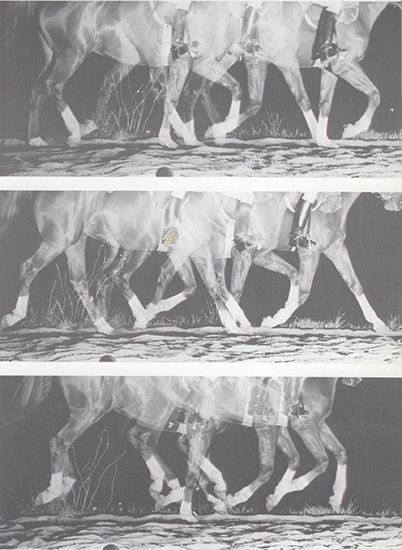
When you think about it, horse training is fraught with difficulties from the start because we sit on the animal and can use our two reins and seat and posture and legs to stimulate the horse, but not all of these aids can ensure a response in a challenging circumstance or when the horse simply doesn’t feel like responding. So we need to divide our aids into those that can reliably obtain a response (operant conditioning) and those that can maintain it when things are going well (classically conditioned aids.) The operantly conditioned aids are those of reins and legs so we need to have distinct and easily discriminated aids for gait, tempo and stride-length changes as well as lateral steps of fore and hindlegs. Then we also need distinct aids for seat and postural associations. Above all, acceleration signals must differ significantly from deceleration signals or confusion is magnified.
WELFARE IMPLICATIONS: Blurred and ambivalent signals can lead to confusion, distress and responses that compromise performance and rider safety
Training must build on the horse’s responses to
your cues…
Shape responses and movements
DOES YOUR TRAINING DEMONSTRATE that, for any behaviour modification, training begins by reinforcing basic attempts at the target behaviour and then gradually improving approximations of that behaviour? The Equitation Science shaping scale begins at a Basic Attempt, then any response or movement is trained to be elicited immediately and from a light aid. Next Rhythm is trained where the horse learns to self-maintain his gait, tempo and stride length. Now Straightness. Unlike the FEI scale where straightness comes in much later (after impulsion and contact) the Equitation Science scale puts it after rhythm because we now know that not only do horses work in diagonal pairs, but that each diagonal pair has different propulsive rhythm characteristics which make horses crooked. Now we have the legs of the horse dealt with. Next is the body of the horse: Contact. Contact is the most elusive of the shaping because much of it develops itself over time in good training. At this level, the continuum of impulsion through to engagement then throughness and finally collection develops through inter-gait and intra-gait transitions that occur in two beats (two foreleg steps in walk and trot and two strides in canter and gallop). The timing is essential for the development of throughness and collection and while most top trainers don’t recognise this timing, most are good at it. As the horse progresses through from impulsion to collection, the seat, leg and rein connections develop which is why rider position is an essential and unavoidable ingredient. The last shaping level involves training the horse in progressively more diverse places so that he becomes reliable anywhere.
WELFARE IMPLICATIONS: Poor shaping can lead to confusion and responses that compromise performance and rider safety.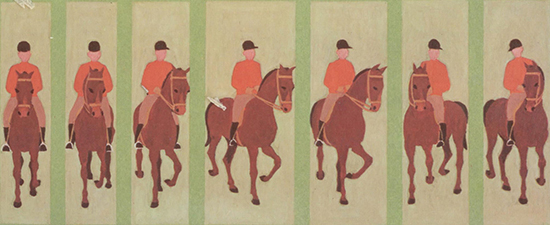
Keep it simple and don’t confuse your horse:
Elicit responses one-at-a-time
DOES YOUR TRAINING DEMONSTRATE that individual cues/signals are separated in time from each other?
Horses have four basic gaits. In walk there are four beats, in trot two beats and in canter three beats. The optimal time to elicit a response is when the leg is in swing phase: on the contrary, stance phase legs are preoccupied by mechanical constraints. So when you want a particular leg to move, you have a small window to ask.
To illustrate this point, think of a canter pirouette. You have three separate swing phase beats to ask each leg to do something different. The leading foreleg in swing phase can be asked to turn, the outside hind can be asked to yield, and the outside foreleg and inside hind pair can be asked to shorten to make the pirouette smaller. These all occur at different times to make training more efficient.
Of course riders get away with it by asking at the wrong times, but when this happens dullness begins to set in. When you ask for something that the horse cannot do, he gradually becomes less reactive, and this is commonly the reason stronger artificial aids and gadgets are used. While simultaneous cues for different responses inhibit each other and become gradually desensitised, with contradictory cues that are applied simultaneously, such as those for acceleration and deceleration, the desensitisation effects are magnified and confusion and stress are likely to set in. With education, cues can be issued closer together. Cues are like words and need separation and the very best riders do so. This principle also highlights the point first made by Pluvinel in the early 17th century that the walk was the main gait for training (because all four legs are separated and in comparatively slow motion) while the trot was the gait for suppleness.
WELFARE IMPLICATIONS: Clashing cues weaken stimulus control and can lead to confusion and responses that compromise performance and rider safety.
Keep your signals separate…
Train only one response per signal
DOES YOUR TRAINING DEMONSTRATE that each signal elicits a single response? (However, each response can be elicited by more than one signal.) Above all, acceleration signals must be separated from deceleration signals. This is an area of intense importance because rein aids are often used to make the horse rounder, which can confuse deceleration effects. Single reins are often used to bend the neck, which can confuse the basic turns, and the rider’s legs are frequently used for all three above mentioned acceleration responses, as well as bending and turning. The best you can do for your horse is to think long and hard about how unique each signal is for each response and to ask yourself – are the problems you see in him a result of confusion?
WELFARE IMPLICATIONS: Ambiguous rein and leg signals lead to confusion and responses that compromise performance and rider safety.
The good trainer is consistent:
Form consistent habits
DOES YOUR TRAINING DEMONSTRATE consistency, so that in training new responses, training is set up in the same context each time, and the same signals are used on the same part of the horse’s body or in the same location relative to the horse’s body? After each response is consolidated, the locations can be gradually altered. Shape transitions to be of the same structure and duration each time. Horses are highly context-specific animals: you often see that they will react in the same way in the same place each time. For example on a circle trainers will frequently notice that the horse improves on one part of the circle and only gradually does this improvement extend to other parts. It makes sense to train the horse in the same way, and same place, each time until consolidation. While it is important to change rein often, it may also be expedient to stay on the same rein when learning something in particular, until the horse seems to ‘get it’, and then change rein. Changing the recipe can make it harder for the horse to learn.
Remember what habits actually are. They are about biomechanically repeating something until it becomes a fixed action, as in ballet or martial arts. The timing of the transitions (gait, tempo, stride length, movement) is often ignored by riders, however it shouldn’t be. If the timing of transitions is trained and maintained within a certain number of footfalls, then the transitions become locked into habit. If you look at the best in the world, e.g. Charlotte Dujardin and Valegro, you will see that her transitions are almost always in two beats of the forelegs in walk and trot and in two strides in canter. I have measured this on slow motion video for years and this is constant. When I have discussed it with the best trainers in world, they usually don’t know that this is what they are doing, yet they have a subconscious ability to aim for this consistency. Consistency makes horses calm and secure because they give him a sense of predictability and controllability.
WELFARE IMPLICATIONS: Inconsistent training can lead to dull responses that compromise performance.
Set your sights high: self carriage…
Train persistence of responses (self-carriage)
DOES YOUR TRAINING DEMONSTRATE the duration of locomotory responses, so that the horse learns to ‘keep going’ in rhythm, straightness and outline to avoid any need for constant signalling and the risk of the horse habituating to signals? Self-carriage is subject to various interpretations, however a more concrete one is that the horse should self-maintain his responses and movements. If you tell me you have trained a bird to sit on your arm, then I’ll only believe you if you let go of its wings. The same is true in riding. We should train the horse to ‘go on his own’ which is a 300 year old concept. It means that the horse should maintain his speed, straightness and outline himself, and you should be able to let go of the reins for two or three beats (überstreichen) with no change in at all. If you release the reins for longer than two or three beats (anlehnung) then the horse should stretch to the contact but still maintain his speed and straightness.
Holding the horse round can lead to short necks and the biggest problem of short necks apart from orthopaedic and neural effects (compression of spinal cord and spinal nerves) is the closing of the gullet which can induce closing of airways and breathing restrictions.
WELFARE IMPLICATIONS: The consequences of a lack of self-carriage range from dull responses to hyper-reactive responses that compromise performance, welfare and rider safety.
Beware of the flight response, it can affect your
horse’s health:
Avoid and dissociate flight responses (because they resist extinction and trigger fear problems)
DOES YOUR TRAINING DEMONSTRATE the avoidance of flight responses? Flight responses have unique characteristics, such as resistance to extinction, and may reappear spontaneously. Flight response behaviours are often accompanied by:
1. Raised catecholamine activity (e.g., increased adrenaline concentration)
2. Increased hyper-reactivity.
3. Aggression, including redirected aggression.
4. Conflict and displacement behaviours.
If stress continues, the following may occur:
1. Raised glucocorticoid activity (e.g., increased cortisol concentration).
2. Learning and memory deficits.
3. Compromised immunity.
4. Digestive disturbances.
5. Ritualisation of original conflict behaviours.
6. Redirected aggression.
7. Long-term insecurity (e.g., separation-related distress, fence walking, fear of conspecifics or horse shyness and increased neophobia). When these symptoms show up, trainers should analyse their management and training programmes and reflect on how they can re-design them. Some horses are more prone to stress than others, but nevertheless it still is of the highest priority to be sure that the trainer and the living and training environment are not the cause of the stress.
WELFARE IMPLICATIONS: Acute stress shows up as problem behaviours (escape, aggression, apathy). Chronic stress has very serious welfare implications, including learned helplessness, and can be fatal.
Good training is relaxed training…
Demonstrate minimum levels of arousal sufficient for training (to ensure absence of conflict)
DOES YOUR TRAINING DEMONSTRATE appropriate relaxation? Trainers should be able to show that the horse is as relaxed as possible for the particular activity or learning circumstance. Certain levels of arousal, muscle tone and attentiveness are required for successful learning, but when these levels are exceeded, learning and welfare suffer. So the best practice is to achieve the level of arousal that is optimal for the learning of the particular response and try not to exceed it. This also means not to overtrain. It makes sense to try to achieve a set of just three correct repetitions in a row with a small break, then another three and finally another three. I say three because the first set can take many repetitions to achieve a row of three correct ones. Training in this way has been shown to be efficient without over doing it and avoiding too high arousal levels. It has been shown that 5 or 10 correct consecutive repetitions is only marginally more efficient than three. 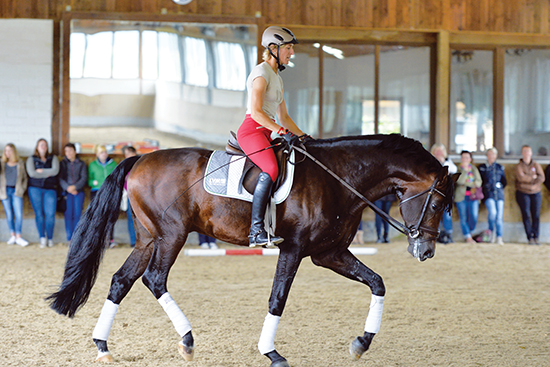
A break between repetitions…
WELFARE IMPLICATIONS: Too much arousal may lead to compromised welfare, which may show up as acute/chronic stress (escape, aggression, apathy).
So there it is, a simple 10 point check list. Does your training program pass the test?



good reminders.